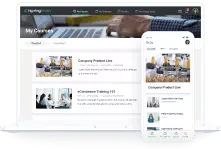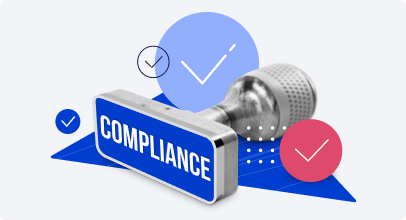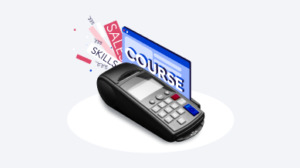Communication Skills Training for Sales Reps: How to Boost Team Performance with eLearning

Some people could sell a bicycle to a fish or talk a hound off a meat truck. Their secret? They’ve mastered the art of sales communication. Unfortunately, communication is so ubiquitous that it’s easy to take for granted. But if you look at any flourishing sales department, you’ll notice they have one thing in common – the gift of gab. But this is not necessarily a natural talent. This ability can be taught, practiced, and improved upon over time! Keep reading to find out how to create effective sales communication skills training and deliver it online with ease.
What Is Sales Communication?
Sales communication is the art of exchanging meaningful messages that demonstrate a product’s value. The interaction can occur both face-to-face or virtually. While the ultimate aim is to close sales, effective sales communication occurs when your team approaches the customer as a problem-solver (versus “product-pusher”).
Why Is Sales Communication Training Important?
When it comes to communication in sales, there’s more than meets the eye. At its core, sales communication is all about asking the right questions and listening closely to customers. That way, your employees will be able to better strategize when fine-tuning their message, building rapport, and not only closing sales but fostering brand and customer loyalty.
Evidently, sales and communication skills are essential! But, of course, practice makes perfect. And too many ill-informed errors during the sales process can really do a number on your business’ reputation and profits. Online sales communication training provides employees with a safe simulated environment in which to err without negative consequences.
Since humans learn best from experience, the more your training environment mimics the pressure and problems of the sales process, the more beneficial it will be.
8 Crucial Sales Communication Skills
It’s one thing to recognize the importance of sales communication training, but yet another to execute it well. There are so many dimensions of communication, including nuances, body language, and reading between the lines. So before you create a plan for employee training, you’ll need to know which skills are the most important to hone.
1. Know everything about your products
To be taken seriously by your clients, you need to speak with authority. This involves gaining the knowledge to become a confident, convincing, and credible professional. So, provide your sales reps with comprehensive information on your products: their functionalities, advantages, values for customers, etc.
2. Familiarize yourself with sales standards and best practices
The core of this skill is aligning your customers’ needs with their pain points in order to deliver a sales experience that aligns with your brand. There are countless sales theories and models that demonstrate what influences a buyer’s decision, including the BANT framework, “right set of circumstances,” and “buying formula” theories of selling. Understanding buyer motivations is key to effective sales communication.
3. Practice active listening
While most people listen, few of us have mastered active listening. According to Stephen R. Covey, “The biggest communication problem is that we do not listen to understand. We listen to reply.” That’s where the “active” in active listening comes in. Active listening involves making eye contact, nodding to let customers know you’re “with” them, and repeating things back with follow-up questions to ensure you’re on the same page.
4. Understand the nuances of body language
Knowing the nuances of nonverbal language is critical to effective sales communication. Not only does it help you send out the right signals, but it helps you get a good read on what a customer is feeling at that moment. That way, rather than missing out on key cues by trying to prepare your next response, you’ll be able to anticipate where the conversation is headed and adjust smoothly.
5. Be authentic
Nothing is more grounding than an authentic person who makes you feel comfortable in your own skin. As such, authentic salespeople enable customers to drop their guard and communicate more freely. This, in turn, empowers salespeople to target a customer’s precise problem and solve it with a sale! But authenticity is tricky, since – by nature – it can’t be faked. You’ll need to forget you’re on the sales floor, to some degree, and approach customers without having an obvious angle.
6. Handle objections with grace
Communication in sales contexts involves the delicate balancing act of moving toward the result you intend without overstepping boundaries. In other words, it involves “convincing without coercing.” Handling objections is difficult, but few things are more off-putting than a salesperson who invades your space, can’t pick up on a clue, or won’t take no for an answer.
When you pester or coerce someone, you are hammering the same points over and over. The trick is understanding why the customer isn’t biting, in order to steer the conversation in a more fruitful direction.
7. Be comfortable with silence
For many, silence can be unsettling. As such, we have the inclination to “fill” silences with idle chatter or questions. But in sales communication, this actually works against you. Embracing silence gives your customer the chance to think their responses through, and it gives you time to think and/or anticipate what those responses might be to react appropriately. In essence, effective sales communication involves “being comfortable with being uncomfortable.”
8. Practice your presentation skills
Effective sales communication also entails practicing your presentation skills. Simple public speaking devices like “pause and punch” come to mind here, in which salespeople leverage the timing of pauses to enhance suspense, curiosity, and thus interest. But presenting products isn’t all about you and your sales team – it’s about finding your unique style of being authentic and engaging, all while speaking confidently.
How to Create Online Sales Communication Training
Now that we’ve covered the most crucial sales and communication skills that your employees need to acquire, it’s time to put it all into practice. Traditional sales training takes place in face-to-face contexts or on-site workshops. But now, the way of the day is online training. Not only is it far more effective and engaging, but you minimize overhead costs and disruptions to regular business operations.
If you’ve never created an online course before, you might imagine some insurmountable learning curve. But most of it can be eliminated with the right software. So keep reading. We’re going to break this process down for you in 4 simple steps.
Step 1. Conduct a training needs analysis
While conducting your training needs analysis, it’s important to develop a strategy that clearly outlines your learning goals (what you want to teach) and learning objectives (what skills employees should achieve).
SWOT is a key acronym that you’ll need to know here. It is indispensable when gauging which knowledge and skills gaps your sales team has. SWOT stands for:

SWOT training needs analysis
While SWOT analyses look great on paper, they’re utterly useless without properly aligning it with your unique training needs. The key is to focus on your weaknesses vs. strengths. For example, your sales team might be naturally extroverted and outgoing. But if they’re unable to, say, turn “refunds” into “replacements,” then that’s a weakness. Remember, you’re trying to fill knowledge gaps. As such, your training should emphasize the weaknesses versus strengths revealed by your SWOT analysis. As far as your strengths go, if something isn’t “broken,” then there’s no need to “fix” it.
One of the best ways to put SWOT into practice is by creating a “skills matrix” to assess the skills specific to your sales team, as exemplified below.

Skill matrix and competency evaluation diagram
Step 2. Research and create an outline
You can’t find a solution to an unknown problem. So now that you’ve clarified which areas need improvement, you can conduct research with purpose and direction. That way, the content that results from it will be focused, relevant, and highly applicable.
But research is a bit trickier when it comes to communication in sales. In this case, your greatest resources will be your sales team and customers. In other words, now is a great time to conduct surveys with thoughtful questions that not only measure and assess the way your team handles certain situations in the sales process, but also their performance in the eyes of customers.
The image below provides a sample survey containing thoughtful, open-ended questions that you can distribute internally to your team. But these barely scratch the surface. Try thinking of more questions on your own.
- What is your biggest obstacle to converting customers/closing sales?
- What are the most common types of questions that customers ask?
- What questions do you commonly ask customers to ascertain their needs?
- At what point would you stop pursuing a sale with a customer?
- What are some difficult situations with customers that you turned into a sale?
- What aspect of sales communication comes easiest to you? What comes hardest?
- Describe a scenario where you lost a sale from an interested prospect. What do you think went wrong?
In addition to surveying your team and sales prospects, there are countless credible sources dealing with topics like non-verbal communication, which is a subsection of the broader study of emotional intelligence. The psychology literature in this domain is immense and will help you train your sales team to develop the 8 key sales communication skills we covered earlier.
Once you’ve researched everything you need to address your learning goals and objectives, you then have all the pieces of the puzzle you need to turn it into an outline or a curriculum!
Step 3. Create content
Now it’s time to get writing to flesh it out! Your content should provide your sales personnel with three types of opportunities:
- The opportunity to learn about tried and tested sales theories and models. That way, your sales team can leverage knowledge about what motivates buyers and work their sales communication along these lines.
- The opportunity to test how well your sales team retained the information. This involves creating assessments.
- The opportunity to practice sales communication (and thus make mistakes) in a safe-to-fail setting. Therefore, you’ll need to script some role-play scenarios that exemplify how best to deal with certain customer “cohorts” (e.g., irate, tentative, or frugal customers).
There are a few types of role-play scenarios that are super helpful for sales communication training, including:
The “on-the-fence” customer
There are always going to be customers who are hesitant or have many objections to hurdle over before you can close the sale. This is where your employees are going to have to practice their powers of persuasion. These customers are highly convertible when you ask the right questions. But remember: persist, but don’t be a pest! Let them climb down from the fence instead of pushing them off.
The “dissatisfied” or “cranky” customer
This sales communication scenario is classic, yet one of the hardest to master. When you master it, you can spot cranky customers from a mile away and predetermine how best to disarm them. This scenario also enables employees to flex their active listening skills.
The “know it all” customer
This type of scenario isn’t necessarily negative. It also includes detail-oriented, tech-savvy, and/or professional-level customers. So the key sales communication skill here is simply knowing your stuff and being authentic. Let’s say a passionate gamer came in looking for an ergonomic gaming chair. If you know your stuff, then it’s easy to build rapport and close a sale. But even if you’re not a gamer, per se, taking a genuine interest in their needs and asking personal questions about their hobby goes a long way.
The “frugal” customer
These customers are hard to combat, but salespeople often turn these customers around using the right sales communication tactics. Here, the tone of voice is everything. Sometimes, they’re indignant at the price. But other times, their tone is more of a question – that is, they’re inviting you to justify the cost. So many key sales communication tactics are at play in these scenarios, including speaking with authority, building trust with authenticity, and practicing active listening.
Of course, this list is generic and goes for most sales contexts. Your business is bound to have its own unique yet typical scenarios.
Now that you know what your course should include, look at your outline and note down (in your computer or in a physical notebook, whatever you like) which lessons/topics/modules are ideal for the core, informational part of the course, where assessments should be added, and for which modules you need to create role-play scenarios.
Once you have a course structure, it’s time to prepare content for your course. Write a script and find all the necessary media.
Step 4. Build your course
Now that you have all the content for your course, you need to put it together with an authoring tool. The eLearning market offers innumerous tools to help you build slides and create assessments and quizzes, but we’ve already discussed how important it is to use role-plays for sales training as well. And only a few authoring solutions can create them, such as iSpring Suite.
Now let’s see how to build a course with iSpring.
1. Install iSpring Suite
First, download the free iSpring Suite trial and launch the program. It will appear as an additional tab on the top PowerPoint ribbon.

2. Add all your content to the slides
Let’s start with the core of the course – the theoretical part. Copy and paste all your texts on the slides and add images and videos. Building a course with iSpring is as simple as it was when you created PowerPoint presentations in school.
Check out the demo below to see what a course made with iSpring looks like:
Once you’ve built the foundational part of the course, you might want to check how well your employees absorbed the information. This is where online quizzes come into play.
3. Create a quiz
To create the assessments, click Quiz near the top-left of the iSpring ribbon to open. The tool gives you 14 different quiz types for maximum creative freedom:

Choose the question templates you consider most appropriate for your quiz and populate them with texts and media.
Take a look at this interactive quiz made in iSpring Suite:
4. Build a role-play
Then you can circle back to your course outline and begin building your role-play scenarios with iSpring’s dialogue simulation tool. These simulations leverage branching scenarios to yield unique responses based on the trainee’s input. For example, we mentioned the cranky or disappointed customer. Depending on the salesperson, that conversation could go in many different directions upon the first encounter.

This is the starting branch. There’s a challenge and three choices that produce consequences.
To start creating a role-play, click on Dialog simulation in the iSpring Suite tab.
With iSpring, you can build dialogue trees by clicking “New Scene” and adding a hierarchy of responses that can branch out indefinitely.

Not only does iSpring enable you to build these infinite-possibility dialogue trees, but you can also choose from a wide variety of characters and virtual scenes to make everything as realistic and relatable as possible.
Check out the demo below for a better idea of how a role-play looks:
Ultimately, the right authoring tool balances ease of use with powerful features, flexibility, and customizable options. That way, you can create your sales communication training however you like – all without the added cost and bother of hiring designers and developers.
Once you’re done, publish it to your platform of choice. We highly recommend a learning management system (LMS). Not only will it automatically grade your assessments, but the LMS can provide invaluable insight as to how your sales team is engaging with the content.
Final Thoughts
The importance of effective sales communication training cannot be overstated. From reading body language to demonstrating authenticity, this singular skill can make or break any business. Your company shouldn’t have to shell out thousands of dollars to third-party developers, nor does it need to disrupt ongoing operations with on-site training. The right tools will have you up to speed in no time!
Since you’ve made it this far, why not give iSpring Suite a go? It’s credit card and commitment free!













